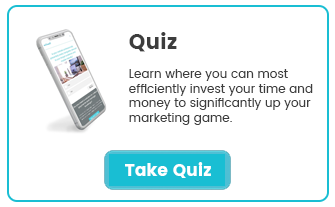Many retreat leaders struggle to market their retreats. The idea of having to put yourself out there and sell spaces either just doesn’t feel right, or it’s simply overwhelming knowing where to begin.
Often, the answer lies in reframing how you think about marketing. You don’t have to be pushing a hard sell to fill spaces. Instead, it's about creating an honest message about the value you can add to your retreat participants. Being your authentic self makes it easier to attract your ideal clients and have them sign up.
While there are many things you can do to promote your retreat, it’s also helpful to know what not to do, as this can hinder your ability to fill spots even if you have a great value proposition. In light of this, we have put together a list of three retreat marketing mistakes you should avoid.
Wonder What's Missing From Your Wellness Business' Marketing Strategy?
Retreat Marketing Mistakes Retreat Leaders Should Avoid
The marketing strategies you pursue to promote your retreat are something to consider carefully as they’re crucial to your success. While Google Adwords and Facebook ads have their place in certain marketing contexts, relying solely on these channels is probably not feasible as the cornerstone of your retreat marketing efforts. Retreats are a deeply personal experience; usually, forging a personal connection and building trust are essential before clients will buy in.
For this reason, the retreat marketing mistakes we outline below have a strong focus on nurturing relationships with your audience.
Mistake #1: Neglecting Education-Based Marketing
Why It’s Powerful
Education-based marketing is a strategy to build trust with people over time by sharing insightful knowledge with them on a particular subject.
For wellness professionals marketing a retreat, it provides your prospective participants with answers to questions they have on aspects related to your expertise.
For example, Ayurvedic practitioners are experts on assessing prakruti and vikruti as well as promoting doshic balance.
They can provide insights on how people can use diet, daily routines, and other practices to balance their doshas; it’s the type of expert information that people are eager to learn about and seek online.
As a result, practitioners are well-positioned to share some of this valuable information, in turn establishing trust and credibility with their audiences.
In turn, prospective clients may be inspired by their newfound knowledge, reaching the point where they are ready to sign on for an Ayurveda and yoga retreat with a practitioner who they have come to trust and turn to for information.
As you can see, this type of marketing is content-based. It can be done by writing blog posts, recording videos, hosting webinars, publishing e-books, performing case studies, and so forth.

Why Marketers Avoid It
It is more a long-term marketing strategy to build relationships than something that generates an immediate, quantifiable return on investment.
And of course, producing the content can be time-consuming in itself, although once you have a library going it is possible to reuse and repurpose the materials.
Expert Tips
To prevent this from becoming one of your retreat marketing mistakes, keep in mind that developing an effective strategy for education-based marketing means:
- Identifying an audience who needs your help and working out the best way to reach them.
- Thinking of the questions they need answered, and how your expertise can directly solve their issues.
- Creating an opportunity that will lead to a logical follow-up that you can step in to resolve one-on-one, thereby progressing your relationship of trust.
Mistake #2: Failing To Get The Most From Word Of Mouth Marketing
Why It’s Powerful
It’s empowering when people believe in you enough to make a personal recommendation for the experience you offer. As far as marketing goes, people trust word of mouth as the most credible source for recommendations.
Receiving this stamp of approval is about as good as it gets when it comes to promoting your retreat. Especially since financial transactions between a retreat leader and client generally rely on the strength of the relationship they hold. You will know from experience that there’s often only so many degrees of separation between attendees, your regular clients, their friends, and their family.

Where Marketers Can Fall Short
While your amazing experiences will find a voice through your existing clients, they’re often not adequately prepared to get others to take action and sign up. They don’t have the details or information available, plus they aren’t as knowledgeable as you are on the subject!
Expert Tips
To help your biggest fans along with converting their great intentions into sold spaces for your retreat, you can empower them with:
- Easily shareable online information, such as a Facebook event or email flyer that they can access and forward
- Referral rewards that are immediate and meaningful
- Information to make sure they have a handle on what you’re offering and can relay accurate details (for example, speak about your upcoming retreat at the end of your classes and encourage questions about the offering)
Mistake #3: Using Email Marketing Ineffectively
Why It’s Powerful
Email marketing is opt-in. This means that taking the time to build and nurture an email list can land your retreat and business in front of people who are open to hearing from you and what you have to offer.
As a marketing channel, email communications are key; nearly 99% of people check their messages daily, so you’re likely to be seen and heard in a timely fashion. When compared with the odds of rising to the top of social media algorithms and perfectly matching your social outreach to your clients’ browsing habits, email marketing gives you a better chance of getting eyes on your offer.

How Marketers’ Efforts Miss The Mark
One of the regular marketing mistakes that retreat leaders make is to not work hard enough to make their email stand out in a person’s inbox.
They also rely on the marketing method too heavily and underutilize other channels as it’s easy to manage, inexpensive to set up, and there’s no need to face rejection.
Expert Tips
To make sure that emails to promote your retreat are opened and the content is read, you should:
- Ensure that your recipients’ spam filters don’t flag and file your mail as junk. Optinmonster provides tips on the matter.
- Use an engaging subject line that grabs the readers’ attention and convinces them to open the message.
- Keep your message short, conversational, and speak directly to the audience you're targeting.
- Provide a clear CTA that leaves no guessing as to how you want people to engage and take the next step.
Through It All, Embrace The Learning Curve
Despite the overwhelm you may be feeling at the prospect of whether or not your retreat sells out, keep in mind that this is a valuable process you can learn from. Hardly anyone gets it 100% right the first, or even second time around.
The good news is that you already have a host of clients who believe in you to get you started. From there, it’s a case of expanding your influence by crafting a message that resonates with the people you want to attract to your retreat and then reaching them on the right channels.
For more advice from a supportive community, get in touch on our Facebook Retreat Leader Hub. Or check out our online retreat leader resources here for useful tips on all aspects of your retreat planning, organizing, and marketing.
New resources, straight to your inbox
We’re committed to your privacy. WeTravel uses the information you provide to us to contact you about our relevant content, products, and services. You may unsubscribe at any time.





